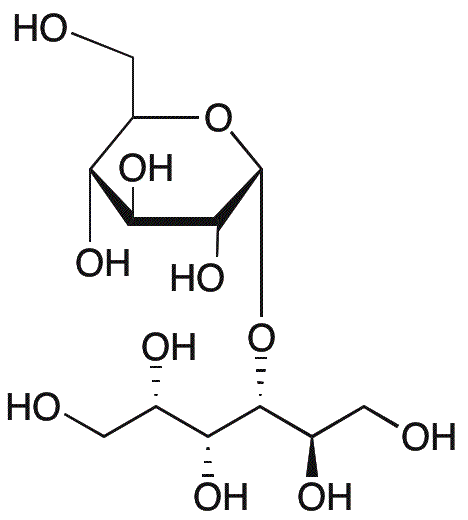Maltitol is widely utilized in research focused on:
- Food Industry: Commonly used as a sugar substitute in low-calorie and sugar-free products, maltitol provides sweetness without the calories of sugar, making it ideal for diabetic-friendly foods.
- Pharmaceuticals: Acts as a filler and sweetening agent in various medications, enhancing patient compliance, especially in pediatric formulations where taste is crucial.
- Cosmetics: Incorporated in skincare products for its moisturizing properties, maltitol helps improve skin hydration and texture, making it a popular choice in lotions and creams.
- Dental Products: Used in sugar-free chewing gums and mints, it does not contribute to tooth decay, offering a healthier alternative for oral care products.
- Biotechnology: Serves as a cryoprotectant in the preservation of biological samples, helping to maintain cell viability during freezing and thawing processes.
General Information
Properties
Safety and Regulations
Applications
Maltitol is widely utilized in research focused on:
- Food Industry: Commonly used as a sugar substitute in low-calorie and sugar-free products, maltitol provides sweetness without the calories of sugar, making it ideal for diabetic-friendly foods.
- Pharmaceuticals: Acts as a filler and sweetening agent in various medications, enhancing patient compliance, especially in pediatric formulations where taste is crucial.
- Cosmetics: Incorporated in skincare products for its moisturizing properties, maltitol helps improve skin hydration and texture, making it a popular choice in lotions and creams.
- Dental Products: Used in sugar-free chewing gums and mints, it does not contribute to tooth decay, offering a healthier alternative for oral care products.
- Biotechnology: Serves as a cryoprotectant in the preservation of biological samples, helping to maintain cell viability during freezing and thawing processes.
Documents
Safety Data Sheets (SDS)
The SDS provides comprehensive safety information on handling, storage, and disposal of the product.
Product Specification (PS)
The PS provides a comprehensive breakdown of the product’s properties, including chemical composition, physical state, purity, and storage requirements. It also details acceptable quality ranges and the product's intended applications.
Certificates of Analysis (COA)
Search for Certificates of Analysis (COA) by entering the products Lot Number. Lot and Batch Numbers can be found on a product’s label following the words ‘Lot’ or ‘Batch’.
*Catalog Number
*Lot Number
Certificates Of Origin (COO)
This COO confirms the country where the product was manufactured, and also details the materials and components used in it and whether it is derived from natural, synthetic, or other specific sources. This certificate may be required for customs, trade, and regulatory compliance.
*Catalog Number
*Lot Number
Safety Data Sheets (SDS)
The SDS provides comprehensive safety information on handling, storage, and disposal of the product.
DownloadProduct Specification (PS)
The PS provides a comprehensive breakdown of the product’s properties, including chemical composition, physical state, purity, and storage requirements. It also details acceptable quality ranges and the product's intended applications.
DownloadCertificates of Analysis (COA)
Search for Certificates of Analysis (COA) by entering the products Lot Number. Lot and Batch Numbers can be found on a product’s label following the words ‘Lot’ or ‘Batch’.
*Catalog Number
*Lot Number
Certificates Of Origin (COO)
This COO confirms the country where the product was manufactured, and also details the materials and components used in it and whether it is derived from natural, synthetic, or other specific sources. This certificate may be required for customs, trade, and regulatory compliance.


